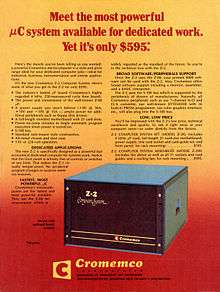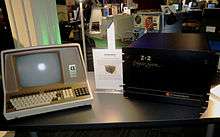Cromemco Z-2

Z-2 is the name of a series of microcomputers made by Cromemco, Inc. which were introduced to the market in the middle to late 1970s.

They were originally available in assembled or kit form to serve both a commercial market and the computer enthusiast market. Later the machines were only available factory-assembled. These Cromemco machines were widely respected for their speed, configurability, durability, and reliability.[1][2][3][4]
The Cromemco Z-2 computer was a Z80–based microcomputer system that was introduced in 1977. The original Z-2 in kit form included a ZPU-K Z80 CPU card, S-100 bus motherboard, all-metal rack-mount chassis and dust case, card socket and card guide; the assembled form included a complete set of sockets and card guides, and a cooling fan. The Z-2 series was capable of supporting up to 21 S-100 boards and could be configured with any of the boards supplied by Cromemco.[5]
The Z-2 gave an impression of solidity due to its hefty 450-watt power supply and heavy metal chassis. A TU-ART (dual serial and parallel board), 4FDC Floppy Disk Controller, one or more 16KZRAM cards, and a Wangco 5¼" floppy disk drive would be added to form a basic system.
An unusual feature of the Z-2 was switch–selectable CPU speed; 250 or 500 nanosecond cycle time were available. The ZPU speed was 4 MHz at a time when less than 2 MHz was normal, and boards from other manufacturers might still require the slower speed. The ZPU card in the Z-2 could address up to 64 kilobytes of RAM. However, the 16KZ memory card supported bank-switching with 8 banks of 64 kilobytes each. When using the 16KZ, the maximum RAM of the Z-2 was limited by the available S-100 slots. If 16 of the slots were occupied by 16KZ cards, then the system had 4 banks of 64 kilobytes each, for a total of 256 kilobytes.
Additional S-100 slots were required for cards controlling peripherals, disk drives, and I/O interfaces. Communication with the processor was normally performed through a TU-ART or other S-100 bus compatible interface card, which could run a CRT terminal or teletype.
Cromemco Z-2D
The Cromemco Z-2D computer was a Z80–based microcomputer system which differed from a Z-2 by having one or two Wangco 5¼" disk drives, a disk power supply and a 4FDC disk controller in a Z-2 chassis. The Z-2D was available in assembled and kit form. The Z-2D was also called the "System Two". [6]
Cromemco Z-2H

The Cromemco Z-2H computer was based on the Z-2D, but in addition had an 11 megabyte internal hard disk drive.[7] While the Z-2 and Z-2D had 21 S-100 slots, the Z-2H was limited to 12 expansion slots due to the size of the internal hard disk. Over 1000 Z-2H systems were sold in the first six months on the market.[2] The 11-megabyte hard disks were also offered as a separate unit, the HDD, that could be used with a Z-2D computer. The HDD came with either one or two hard disks, for up to 22 megabytes of storage.[8]
| System | Year Introduced | S-100 slots | Internal Floppy Disk | Internal Hard Disk |
|---|---|---|---|---|
| Z-2 | 1977 | 21 | n/a | n/a |
| Z-2D | 1978 | 21 | 2 x 5-inch | n/a |
| Z-2H | 1979 | 12 | 2 x 5-inch | 11 megabytes |
Notable installations
The Chicago Mercantile Exchange (CME) adopted Cromemco Z-2 microcomputers as the backbone of the CME trading floor, employing a total of 60 Z-2 systems.[9] For a 10-year period every trade at the CME was processed by these Cromemco systems. In 1992 the Cromemco systems were replaced by IBM PS/2 computers.[10]

Z-2 computers were well-suited for data acquisition and analysis applications. One example was work in profiling the deceleration of trains during braking in the San Francisco Bay Area Rapid Transit (BART) system during actual operation. Cromemco Z-2D computers were employed both for data acquisition and analysis to develop an exact model of the braking profile under a variety of track conditions and train loadings.[11]
The United States Air Force deployed 600 Cromemco Systems from 1985 to 1996 as Mission Support Systems for the F-15, F-16, and F-111 aircraft.[12][13] During this period Cromemco systems were used for the planning of every combat mission for these aircraft, including missions during the First Gulf War. These systems were based on the Cromemco Z-2 computer, but utilized the Motorola 68020 32-bit processor, and had a custom, removable hard drive to meet the Air Force need to be able to physically secure all flight plan information. Cromemco received a patent on this technology.[14]
References
- ↑ Veit, Stan (1993). "Cromemco: Innovation and Reliability". Stan Veit's History of the Personal Computer. Asheville, North Carolina: WorldComm. pp. 103–112. ISBN 1-56664-023-7.
It was said that circus elephants could stand on the Z-2 without damaging it.
- 1 2 The Association of Computer Users (April 1980). "Cromemco's System Two and Z-2H". Benchmark Report. 3.1 (4).
- ↑ Warren, Jim (7 February 1979). "Report on Outstanding Cromemco Reliability". Intelligent Machines Journal (2): 4.
- ↑ Stevens, Richard (February 1979). "Cromemco Z-2D under the microscope: Construction never less than excellent". Practical Computing. 2 (2). Retrieved 3 March 2013.
- ↑ Cromemco Z-2 Instruction Manual, Cromemco,Inc. Part No. N/A, 1977
- ↑ Cromemco Z-2D Instruction Manual, Cromemco,Inc. Part No. 0023-0014, 1978
- ↑ "Z-2H Brochure". Cromemco. Retrieved 3 March 2013.
- ↑ "HDD Disk Memory System Brochure". Cromemco. Retrieved 3 March 2013.
- ↑ Breeding, Gary (January–February 1984). "Cromemco Systems Network Transactions at Chaotic Exchange". I/O News. 3 (6): 20. ISSN 0274-9998.
- ↑ "CME Taps Datacode To Distribute Quotation Data To Floor Traders". WatersTechnology. 27 January 1992. Retrieved 3 March 2013.
- ↑ G. Rothbart; R. Fullwood; H. O. Conde (4–6 December 1978). "Automatic data acquisition and processing of train deceleration for rapid transit train systems". Proceedings 1978 ACM Annual Conference, Washington, DC, USA, Volume II: 612–616. Retrieved 3 March 2013.
- ↑ Kuhman, Robert. "The Cro's Nest RCP/M-RBBS". www.kuhmann.com. Retrieved 10 February 2012.
- ↑ "Mission Support". Aviation Week & Space Technology. 126 (22): 105. 1 June 1987.
- ↑ "U.S. Patent #4,870,605". USPTO.